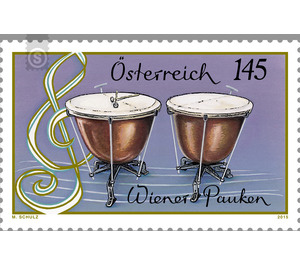Musical instruments - Austria / II. Republic of Austria 2015 - 145 Euro Cent
Theme: Art & Culture
| Country | Austria / II. Republic of Austria |
| Issue Date | 2015 |
| Face Value | 145.00 |
| Edition Issued | 200,000 |
| Printing Type | Combination printing, offset stitch (Etch-Art by OeSD) |
| Stamp Type | Commemorative |
| Item Type | Stamp |
| Chronological Issue Number | 2517 |
| Chronological Chapter | OOS-OE2 |
| SID | 323665 |
| In 64 Wishlists | |
The timpani belongs to the group of so-called Mambranophone and consists of a copper kettle, over which a fur is stretched. Through a special mechanism that changes the tension of the fur, the pitch of the instrument can be varied while playing. Various boiler drums existed thousands of years ago, but paired boiler drums first came to Europe from Turkey and Persia. In 1894, the court Kapellmeister Hans Richter brought the Bohemian paukist Hans Schnellar to the Vienna Court Opera, where he was a member of the Opera Orchestra and the Vienna Philharmonic until 1932. Schnellar also taught at the Conservatory and the Academy of Music and the Performing Arts - but he remembered posterity above all through his technical achievements. Encouraged by the court opera directors Richard Strauss and Gustav Mahler mentioned above, he worked on a Hebelpauke, which he wrote in 1920 finally applied for a patent. As a result, Schnellar's hand-lever timpani learned of course further technical improvements that emphasize the typical sound and should perfect. A peculiarity of the Viennese timpani, which is usually played in pairs in classical occupation, is the covering with a goatskin parchment. This creates a sound image with a stronger tonality.


